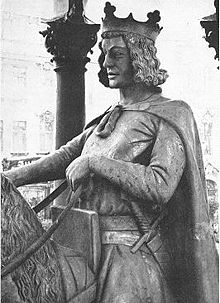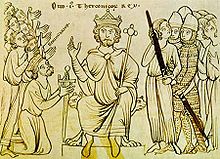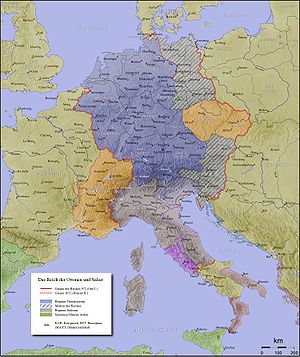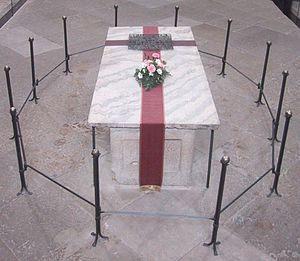- Otto I, Holy Roman Emperor
-
Otto I 
The Magdeburger Reiter: a tinted sandstone equestrian monument, c. 1240, traditionally intended as a portrait of Otto I (detail), Magdeburg King of Germany
(formally King of the Franks)Reign 2 July 936 – 7 May 973 Coronation 7 August 936
Aachen CathedralPredecessor Henry the Fowler Successor Otto II King of Italy
(formally King of the Lombards)Reign 10 October 951 – 7 May 973 Predecessor Berengar II Successor Otto II Holy Roman Emperor Reign 2 February 962 – 7 May 973 Coronation 2 February 962
St. Peter's Basilica, RomePredecessor Berengar of Friuli Successor Otto II Duke of Saxony Reign 2 July 936 – 7 May 973 Predecessor Henry the Fowler Successor Bernard I Consort Eadgyth of England
Adelaide of ItalyIssue illegitimate
William, Archbishop of Mainz
with Eadgyth
Liutgarde of Saxony
Liudolf, Duke of Swabia
with Adelaide
Matilda, Abbess of Quedlinburg
Otto II, Holy Roman EmperorHouse Ottonian Father Henry the Fowler Mother Matilda of Ringelheim Born 23 November 912
WallhausenDied 7 May 973
MemlebenBurial Magdeburg Cathedral Religion Roman Catholicism Otto I the Great (23 November 912 in Wallhausen – 7 May 973 in Memleben), son of Henry I the Fowler and Matilda of Ringelheim, was Duke of Saxony, King of Germany, King of Italy, and "the first of the Germans to be called the emperor of Italy" according to Arnulf of Milan.[1] While Charlemagne had been crowned Emperor in 800, his empire had been divided amongst his grandsons, and following the assassination of Berengar of Friuli in 924, the Imperial title had lain vacant for nearly forty years. On 2 February 962, Otto was crowned Emperor of what later became the Holy Roman Empire.
Contents
Biography
Early reign
Married to Eadgyth of England in 929, Otto succeeded his father as king of Germany (officially still known as East Francia) in 936.[2]
He arranged for his coronation to be held in Charlemagne's former capital, Aachen, where he was anointed by Hildebert archbishop of Mainz, primate of the German church. According to the Saxon historian Widukind of Corvey, at his coronation banquet, he had the four other dukes of the empire, those of Franconia, Swabia, Bavaria and Lorraine, act as his personal attendants: Arnulf I of Bavaria as marshal (or stablemaster), Herman I, Duke of Swabia as cupbearer, Eberhard III of Franconia as steward (or seneschal), and Gilbert of Lorraine as Chamberlain.[3] From the outset of his reign he signaled that he was the successor to Charlemagne, whose last heirs in East Francia had died out in 911, and that he had the German church, with its powerful bishops and abbots, behind him. However, the Neustrian reign (West Francia), had been and still was under the rule of the Carolingian dynasty.
Otto intended to dominate the church and use that sole unifying institution in the German lands in order to establish an institution of theocratic Imperial power.[citation needed] The Church offered wealth, military manpower and its monopoly on literacy. For his part the Emperor offered protection against the nobles, the promise of endowments, and an avenue to power as his ministeriales.
In 938, a rich vein of silver was discovered at the Rammelsberg in Saxony. This mineral wealth helped fund Otto's activities throughout his reign; indeed, it would provide much of Europe's silver, copper, and lead for the next two hundred years.[citation needed]
Otto's early reign was marked by a series of ducal revolts. In 938, Eberhard, the new duke of Bavaria, refused to pay Otto homage. Otto responded with two campaigns in 938, during spring and fall, defeating Eberhard and banishing him. Berthold, Arnulf's brother, formerly duke of Carinthia became new duke of Bavaria.
After the death of Siegfried, Count of Merseburg in 937, Thankmar claimed Merseburg. Otto, however, appointed Gero, Siegfried's brother, as count of Merseburg. During this dispute, Eberhard of Franconia and Wichmann the Elder revolted against Otto and Thankmar joined them. Thankmar and Eberhard of Franconia captured Belecke on the Möhne.[citation needed] Wichmann the Elder was reconciled with Otto and the revolt in Saxony broke down.[citation needed] The fortress of Eresburg was besieged and occupied by the Imperial army and Thankmar was killed by Maginzo at the altar of the church of Saint Peter.[citation needed] Eberhard of Franconia was briefly imprisoned at Hildesheim, but was released and entered into a compact with Henry, Otto's younger brother.[4]
The Rebellion of the Dukes
The revolt continued when Gilbert, the duke of Lorraine, swore fealty to King Louis IV of France. Louis IV of France, in the hope of attaching Lorraine once more to the West Frankish dominions, joined forces with Duke Gilbert. Otto allied with Louis' chief antagonists Hugh the Great, Herbert II, Count of Vermandois, William I, Duke of Normandy and Arnulf I, Count of Flanders.[5] Henry liberated Merseburg then marched to join Gilbert in Lorraine. Otto, besieged them in the castle of Chevremont near Liege, but he was forced to set out against Louis IV of France, who had occupied Verdun. Otto, subsequently drove Louis back to his capital at Laon.
Otto then besieged Duke of Franconia in the fortress of Breisach on the Rhine. During this time, Frederick, Archbishop of Mainz joined his forces with Henry and Gilbert against Otto. Otto’s army, commanded by Konrad Kurzbold, count of Niederlahngau, and his cousin Udo, count of Wetterau and Rheingau, met the rebel dukes' army at Andernach. Eberhard was slain in the fight and Gilbert drowned in the Rhine. Henry fled to France, and Otto responded by supporting Hugh the Great in his campaign against the French crown. In 941, Otto and Henry were reconciled through the efforts of their mother, and the next year Otto withdrew from France after Louis recognized his suzerainty over Lorraine. Later when Otto was at war against the Slavic tribes Henry conspired with Frederick, Archbishop of Mainz, to assassinate him during the celebration of Easter at Quedlinburg. But the plot was discovered and Henry fled, but was later pardoned by Otto.
To prevent further revolts, Otto arranged for all the important duchies in the German kingdom to be held by close family members. He kept the vacant duchy of Franconia as a fiefdom, while in 944 he bestowed the duchy of Lorraine upon Conrad the Red, nephew of Conrad I, who later married his daughter Liutgarde.With death of Duke Berthold in 947 his duchy of Bavaria passed to the king's own brother Henry. Meanwhile, he arranged for his son Liutdolf to marry Ida, the daughter of Duke Herman of Swabia, and to inherit that duchy when Herman died in 947. A similar arrangement led to Henry becoming duke of Bavaria in 949.
War on the eastern frontier
The death of Henry the Fowler, was a signal for the Eastern European tribes to rebel against imperial power. In 936 the Redarii revolted, but were again reduced to submission by Hermann Billung. In 937, Otto defeated Hungarian raids into Saxony.[citation needed] When Otto was in war with his vassals, the Hungarian made new raids into Germany, but they suffered two bloody defeats in the Harz Mountains, near Stetternburg and in the Dromling.[citation needed] In 944, the Hungarians invaded the Empire, but were defeated in Carinthia by Duke Berthold. In 950, Henry defeated the Hungarians that invaded Bavaria.[citation needed] Otto in 950 made an expedition into Bohemia and was recognized as overlord by Duke Boleslaus I of Bohemia.[citation needed]
In the summer of 940, Otto I entered France to punish Louis for his interference in Lorraine. He forced Louis back to the Seine and made him sign a treaty with Burgundy.[why?] In 942, a compact was concluded between Otto and Louis at Vouzieres.[citation needed] In the late summer of 946, Otto again invaded France, but had limited success. Laon, Rheims, and Senlis were all besieged, but only Rheims was captured. The two kings[who?] then made a plundering raid into Normandy, but were unsuccessful and Otto made his way back to Germany.[6]
Campaigns in Italy and eastern Europe
Meanwhile, Italy had fallen into political chaos. On the death (950), possibly by poisoning, of Lothair of Arles, the Italian throne was inherited by a woman, Adelaide of Italy, the respective daughter, daughter-in-law, and widow of the last three kings of Italy. A local noble, Berengar of Ivrea, declared himself King of Italy, abducted Adelaide, and tried to legitimize his reign by forcing Adelaide to marry his son Adalbert. However, Adelaide escaped to Canossa and requested German intervention. Luidolf and Henry independently invaded northern Italy to take advantage of the situation, but in 951 Otto frustrated his son's and his brother's ambitions by invading Italy himself. He received the homage of the Italian nobility, assumed the title "King of the Lombards" and in 952 forced Berengar and Adalbert to pay homage, allowing them to rule Italy as his vassals. Having been widowed since 946, he married Adelaide himself.
When Adelaide bore a son, Liudolf feared for his position as Otto's heir. In 953 he rebelled in league with Conrad, Duke of Lorraine and the Archbishop of Mainz. While Otto was initially successful in reasserting his authority in Lorraine, he was captured while attacking Mainz, and by the next year, the rebellion had spread throughout the kingdom. However, Conrad and Liudolf erred by allying themselves with the Magyars. Extensive Magyar raids in southern Germany in 954 compelled the German nobles to reunite, and at the Diet of Auerstadt, Conrad and Luitdolf were stripped of their titles and Otto's authority reestablished. In 955, Otto cemented his authority by routing Magyar forces at the Battle of Lechfeld (10 August 955) and the Obodrites at the Battle of Recknitz (16 October 955).
The Ottonian system
As a key element of his domestic policy, Otto sought to strengthen ecclesiastical authorities, chiefly bishops and abbots, at the expense of the secular nobility who threatened his own power. To control the forces that the Church represented, Otto made consistent use of three institutions. One was the royal investiture of bishops and abbots with the symbols of their offices, both spiritual, for Otto was the anointed King of the Germans, and temporal, in which Otto secured his bishops and abbots as his vassals through a commendation ceremony.
"Under these conditions clerical election became a mere formality in the Ottonian empire, and the king filled up the ranks of the episcopate with his own relatives and with his loyal chancery clerks, who were also appointed to head the great monasteries" (Cantor, 1994 p. 213). The second institution was more securely established in Ottonian territories, that of the proprietary churches (Eigenkirchen; in English law the right of "advowson").
In German law, any structure built on land owned by a lord belonged to that lord, unless a charter had very specifically conveyed away those rights. Otto and his chancery aggressively reclaimed proprietary rights over many landed churches and abbeys. The third instrument of Ottonian power was the system of the advocatus (German Vogt). The advocatus was a secular manager of ecclesiastical estates, who was entitled to a certain share of the agricultural produce and other revenues and was responsible for safety and good order. Unlike countships, which quickly became hereditary, the Vogt performed the duties of a West Frankish bailli and held his position solely at the continued will of the emperor whom he served.
Otto endowed the bishoprics and abbeys with large tracts of land, over which secular authorities had neither the power of taxation nor legal jurisdiction. In an extreme example, when Conrad the Red was stripped of his ducal title in Lorraine, Otto appointed his brother Bruno – already the Archbishop of Cologne – as the new duke of Lorraine. In the lands Otto conquered from the Wends and other Slavic peoples on his eastern borders, he founded several new bishoprics.
Because Otto personally appointed the bishops and abbots, these reforms strengthened his central authority, and the upper ranks of the German church functioned in some respect as an arm of the imperial bureaucracy. Conflict over these powerful bishoprics between Otto's successors and the growing power of the Papacy during the Gregorian Reforms would eventually lead to the Investiture Conflict and the undoing of central authority in Germany in the 11th century.
The Ottonian Renaissance
A limited renaissance of the arts and architecture depended on court patronage of Otto and his immediate successors. The "Ottonian Renaissance" was manifest in some revived cathedral schools, such as that of Bruno I, Archbishop of Cologne, and in the production of illuminated manuscripts, the major art form of the age, from a handful of elite scriptoria, such as that at Quedlinburg Abbey, founded by Otto in 936. The Imperial abbeys and the Imperial court became the centers of religious and spiritual life, led by the example of women of the royal family. Scandalized by the state of the liturgy in Rome, Otto commissioned the first ever Pontifical Book, a liturgical book containing both prayers and ritual instruction. The compilation of the Romano-Germanic Pontifical, as it is now called, was overseen by Archbishop William of Mainz.
Imperial title
In the early 960s, Italy was again in political turmoil, and when Berengar occupied the northern Papal States, Pope John XII asked Otto for assistance. Otto returned to Italy and on 2 February 962, the pope crowned him Emperor. See Translatio imperii. Ten days later, the pope and Emperor ratified the Diploma Ottonianum, under which the Emperor became the guarantor of the independence of the Papal States. This was the first effective guarantee of such protection since the Carolingian Empire.
After Otto left Rome and reconquered the Papal States from Berengar, however, John became fearful of the Emperor's power and sent envoys to the Magyars and the Byzantine Empire to form a league against Otto. In November 963, Otto returned to Rome and convened a synod of bishops that deposed John and crowned Leo VIII, at that time a layman, as pope.
When the Emperor left Rome, however, civil war broke out in the city between supporters of the Emperor and of John. John returned to power amidst great bloodshed and excommunicated those who had deposed him, forcing Otto to return to Rome a third time in July 964 to depose Pope Benedict V (John having died two months earlier). On this occasion, Otto extracted from the citizens of Rome a promise not to elect a pope without imperial approval.
Otto unsuccessfully campaigned in southern Italy on several occasions from 966 to 972. In 967, he gave the duchy of Spoleto to Pandulf Ironhead, prince of Benevento and Capua, a powerful ally in the Mezzogiorno. In the next year (968) Otto left the siege of Bari in the charge of Pandulf, but the allied duke was captured in the battle of Bovino by the Byzantines. In 972, the Byzantine Emperor John I Tzimisces recognized Otto's Imperial title and agreed to a marriage between Otto's son and heir Otto II and his niece Theophanu. Pandulf was released from captivity.
After his death in 973 he was buried next to his first wife Edith of Wessex in the Cathedral of Magdeburg.
Ancestry
Ancestors of Otto I, Holy Roman Emperor 8. Liudolf, Duke of Saxony 4. Otto I, Duke of Saxony 9. Oda Billung 2. Henry I of Germany 10. Henry of Franconia 5. Hedwiga of Franconia 11. Ingeltrude of Friuli 1. Otto I, Holy Roman Emperor 12. Reginhart Count of Ringelheim 6. Dietrich of Ringelheim, Count of Westfalia 13. Matilde of Dreini 3. Matilda of Ringelheim 14. (perhaps) Godfrid Haraldsson, King of the Danes 7. Reinhild 15. (perhaps) Gisela of Lotharingia Legacy
Emperor Otto I was selected as the main motif for a high value commemorative coin, the €100 Imperial Crown of the Holy Roman Empire commemorative coin, minted in 2008 by Austria. The obverse shows the Imperial Crown of the Holy Roman Empire. The reverse shows Emperor Otto I with old St. Peter's Basilica in Rome in the background, where his coronation took place.
Notes
- ^ Arnulf,Liber gestorum recentium, I.7.
- ^ The ethnonyms for this period are highly political . Cf. (Zeller 2006).
- ^ Widukind of Corvey, Res gestae saxonicum Book 2, chapter 2: duces vero ministrabant. Lothariorum dux Isilberhtus, ad cuius potestatem locus ille pertinebat, omnia procurabat; Evurhardus mensae preerat, Herimannus Franco pincernis, Arnulfus equestri ordini et eligendis locandisque castris preerat; Sigifridus vero, Saxonum optimus et a rege secundus, gener quondam regis, tunc vero affinitate coniunctus, eo tempore procurabat Saxoniam, ne qua hostium interim irruptio accidisset, nutriensque iuniorem Heinricum secum tenuit. Bibliotheca Augustana.
- ^ Holland T. (2009) Millennium. London. Abacus. Page 59.
- ^ Gwatkin ,The Cambridge Medieval History: Volume III. p 189
- ^ Gwatkin ,The Cambridge Medieval History: Volume III.p 193
References
- Charter given by Emperor Otto for the monastery Hilwartshausen showing the Emperor's seal, 12.2.960. Taken from the collections of the Lichtbildarchiv älterer Originalurkunden at Marburg University
- Gwatkin, H. M., Whitney, J. P. (ed) et al. The Cambridge Medieval History: Volume III. Cambridge: Cambridge University Press, 1926.
- Menzel , W. Germany from the Earliest Period . Vol I
- Zeller, Bernhard (2006), "Liudolfinger als fränkische Könige? Überlegungen zur sogennante Continuatio Reginonis", in Corradini, Richard, Text & identities in the early middle ages, Denkschriften (Österreichische Akademie der Wissenschaften. Philosophisch-Historische Klasse), 344. Band . Forschungen zur Geschichte des Mittelalters, 12, Wien: Österreichischen Akademie der Wissenschaften, pp. 137–151, ISBN 9783700137474
Further reading
- Barraclough, G. The Origins of Modern Germany (1946) online edition
- Gallagher, John. Church and state in Germany under Otto the Great (936-973) (1938)
- Hill, Jr., B. H. Medieval Monarchy in Action: The German Empire from Henry I to Henry IV (1972).
- Lasko, Peter. Ars Sacra: 800-1200 (1995) ch 9
- Reuter, Timothy. The New Cambridge Medieval History: c. 900-c. 1024 (2000)pp 250–89
- Thompson, James Westfall. Feudal Germany (1928) online edition
 Chisholm, Hugh, ed (1911). "Otto I". Encyclopædia Britannica (11th ed.). Cambridge University Press.
Chisholm, Hugh, ed (1911). "Otto I". Encyclopædia Britannica (11th ed.). Cambridge University Press.
In German
- Schneidmüller, Bernd. "Otto I." In Die deutschen Herrscher des Mittelalters. Historische Porträts von Heinrich I bis Maximilian I (919–1519), ed. Bernd Schneidmüller and Stefan Weinfurter. Munich, 2003. 35–61. ISBN 3-406-50958-4.
- Laudage, Johannes. Otto der Große: (912–973). Eine Biographie. Regensburg, 2001. ISBN 3-7917-1750-2.
- Althoff, Gerd. "Otto I. der Große." In Neue Deutsche Biographie (NDB) 19. Berlin, 1999. 656–60. Available here
- Althoff, Gerd and Hagen Keller. Heinrich I. und Otto der Grosse: Neubeginn auf karolingischem Erbe. Göttingen, 1985.
- Hiller, Helmut. Otto der Große und seine Zeit. Munich, 1980. ISBN 3-471-77847-0.
- Wies, Ernst W. Otto der Große. Kämpfer und Beter. 3d ed. Esslingen and Munich, 1998. ISBN 3-7628-0483-4.
Otto I, Holy Roman EmperorHouse of Saxony (Liudolfing)Born: 912 Died: 973German royalty Regnal titles Preceded by
Henry IKing of Germany
936–973Succeeded by
Otto IIVacant Title last held byBerengar of FriuliHoly Roman Emperor
962–973Preceded by
Berengar IIKing of Italy
951–973Preceded by
Henry IDuke of Saxony
936–961Succeeded by
HermannMonarchs of Germany Eastern Francia (843–918) 
Saxon Kingdom (919–62) - Henry I
- Otto I
Kingdom of Germany
in the Holy Roman Empire
(962–1806)- Otto I
- Otto II
- Otto III
- Henry II
- Conrad II
- Henry III
- Henry IV
- Henry V
- Lothair III
- Conrad III
- Frederick I
- Henry VI
- Philip
- Otto IV
- Frederick II
- Conrad IV
- Rudolf I
- Adolf
- Albert I
- Henry VII
- Louis IV
- Charles IV
- Wenceslaus
- Rupert
- Sigismund
- Albert II
- Frederick III
- Maximilian I
- Charles V
- Ferdinand I
- Maximilian II
- Rudolph II
- Matthias
- Ferdinand II
- Ferdinand III
- Leopold I
- Joseph I
- Charles VI
- Charles VII
- Francis I
- Joseph II
- Leopold II
- Francis II
Confederation of the Rhine (1806–1813) - Napoleon I
German Confederation (1815–1848) German Empire (1849) - Frederick William IV (emperor-elect)
German Confederation (1850–1866) North German Confederation (1867–1871) German Empire (1871–1918) Categories:- 912 births
- 973 deaths
- People from Mansfeld-Südharz
- Holy Roman Emperors
- German kings
- Roman Catholic monarchs
- Dukes of Carinthia
- Dukes of Saxony
- Ottonian Dynasty
- Burials at the Cathedral of Magdeburg
- 10th-century rulers in Europe
Wikimedia Foundation. 2010.





